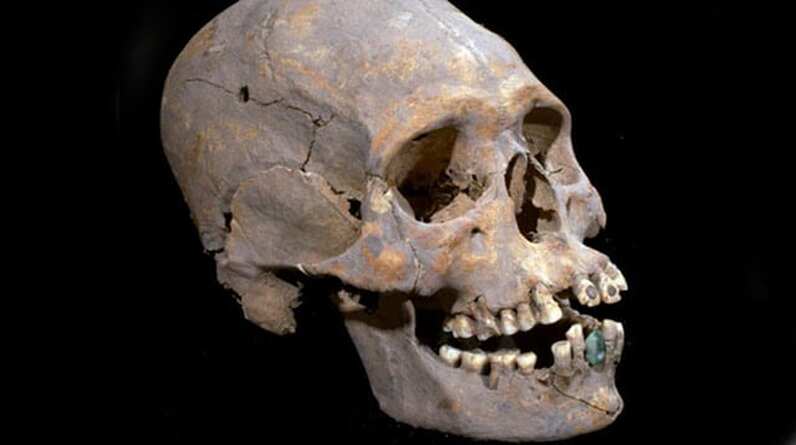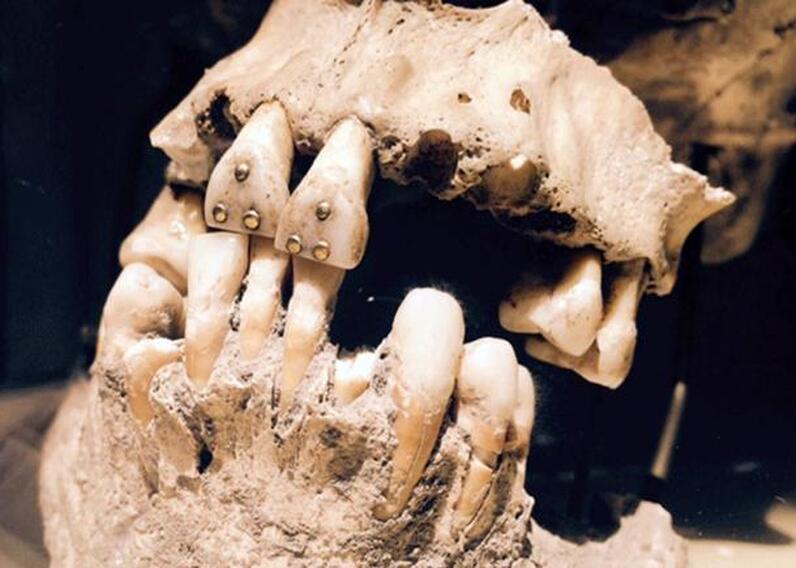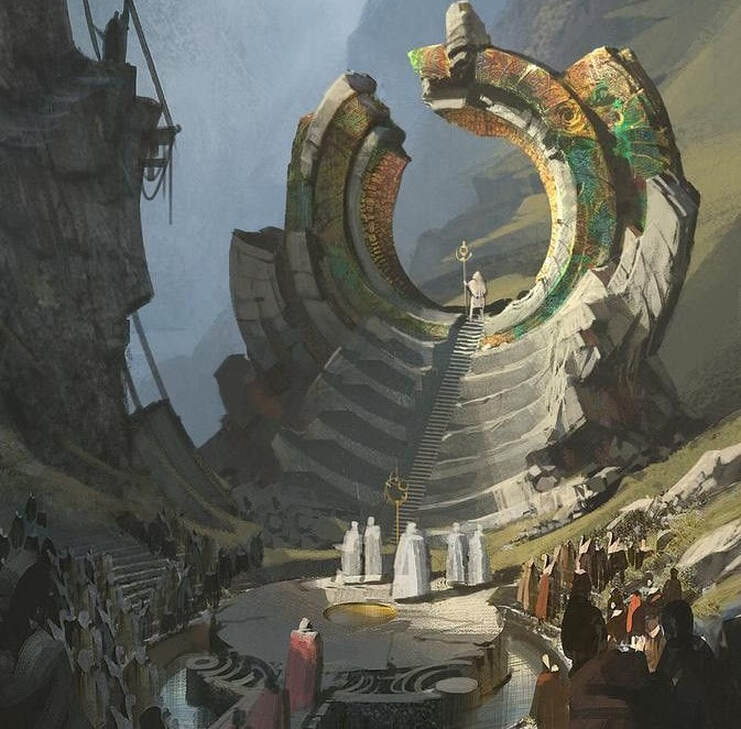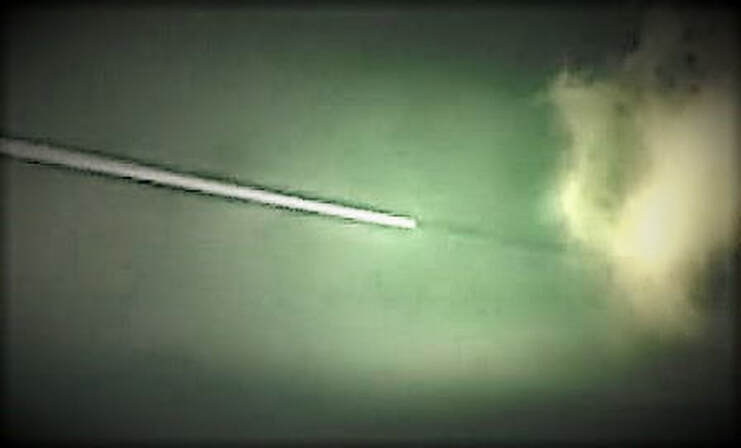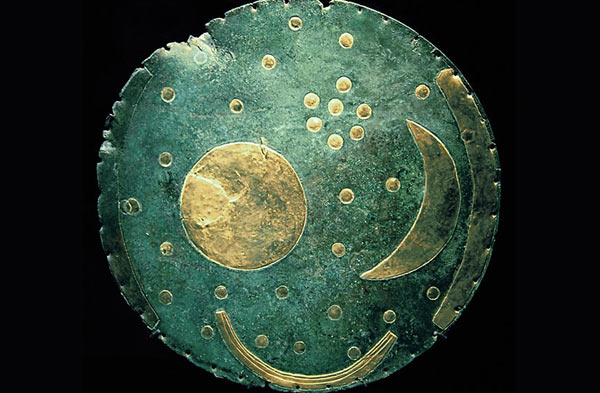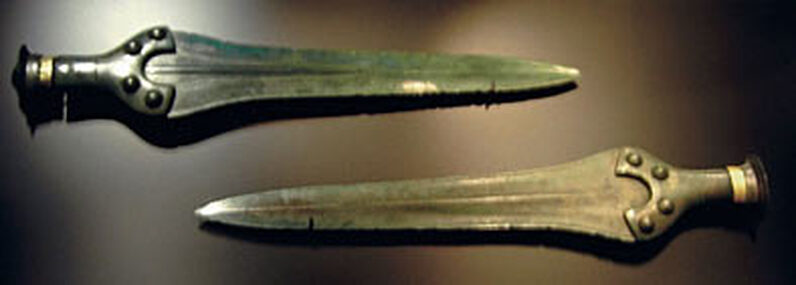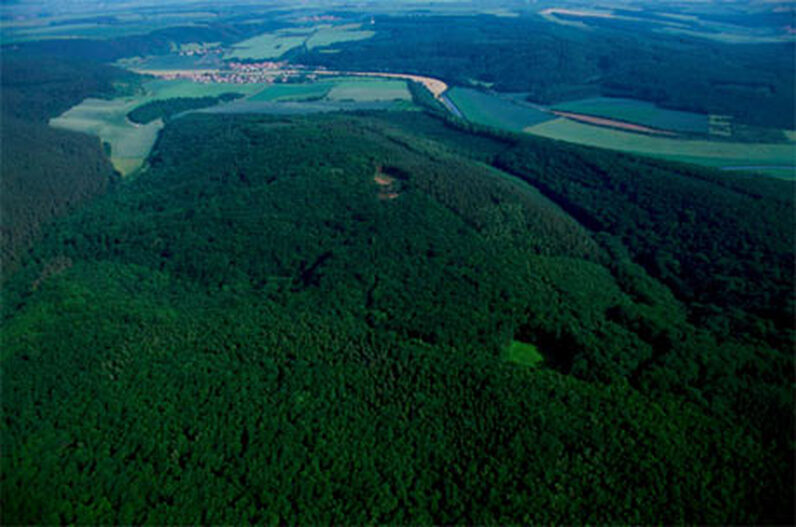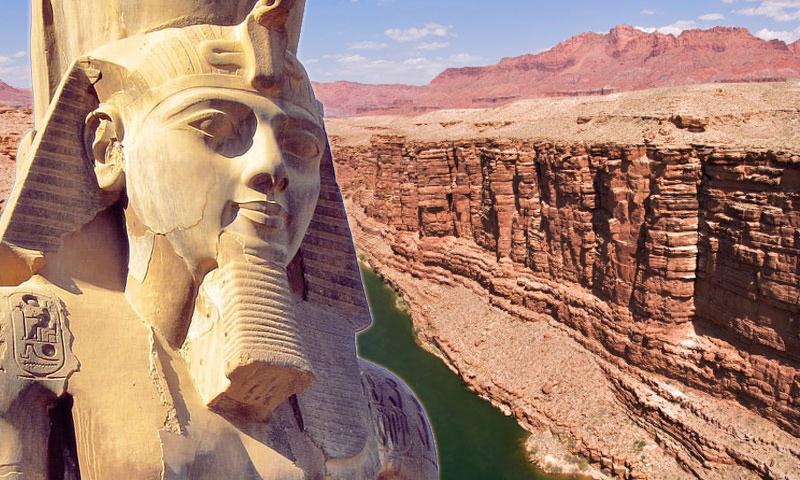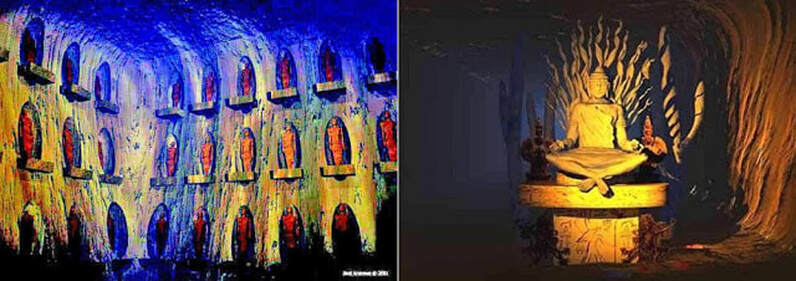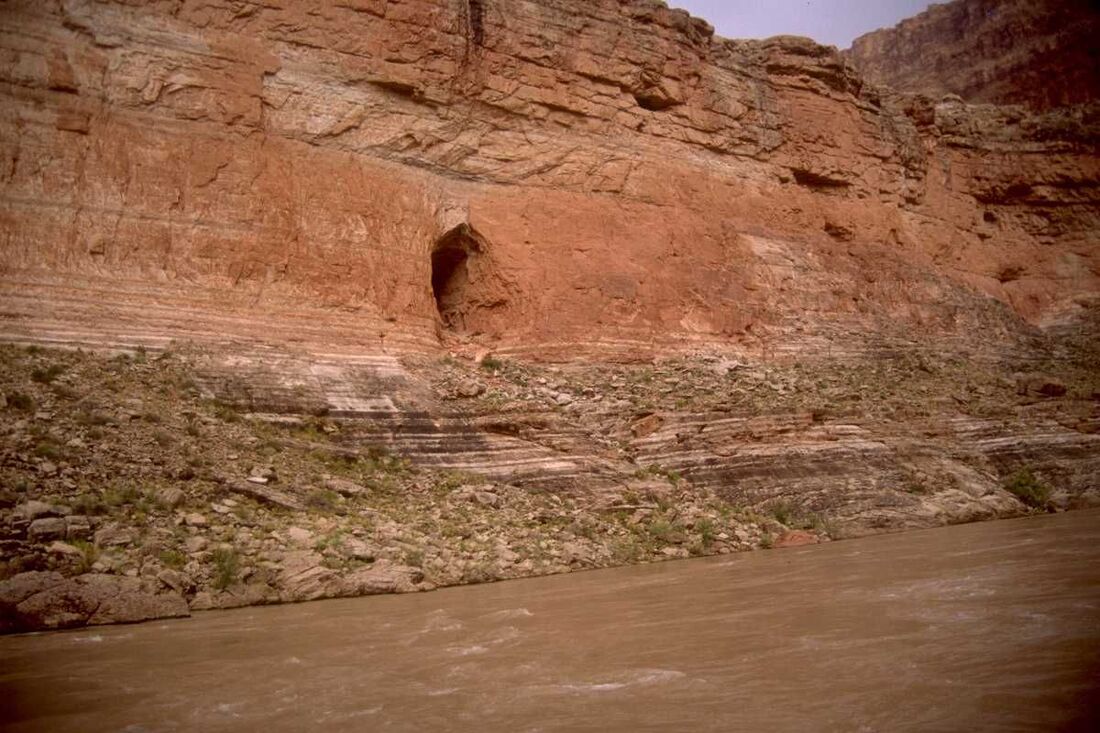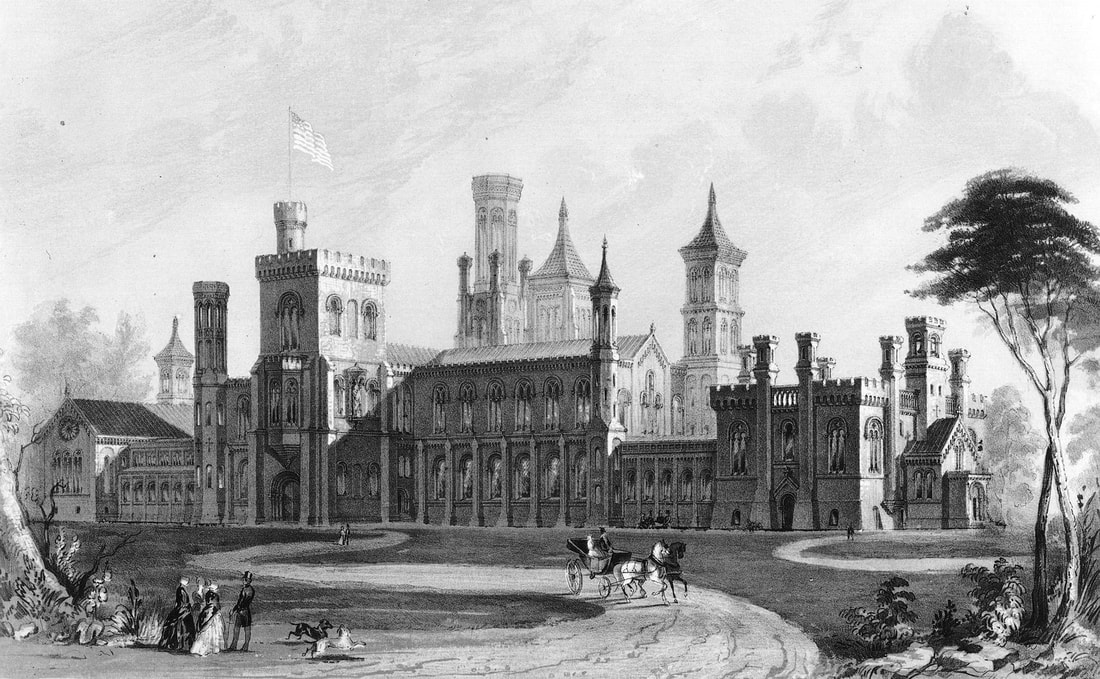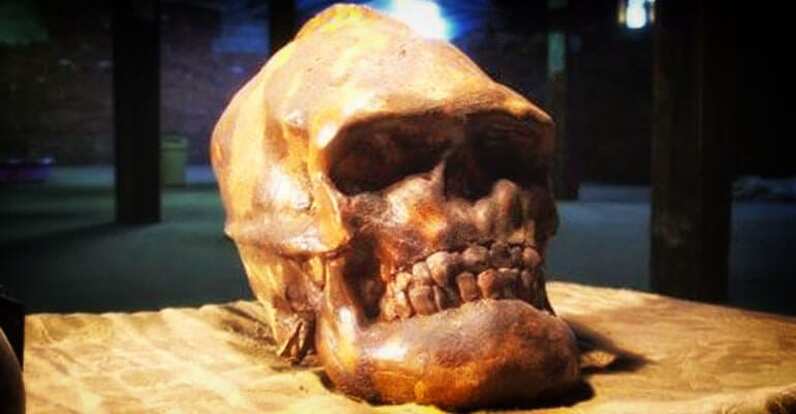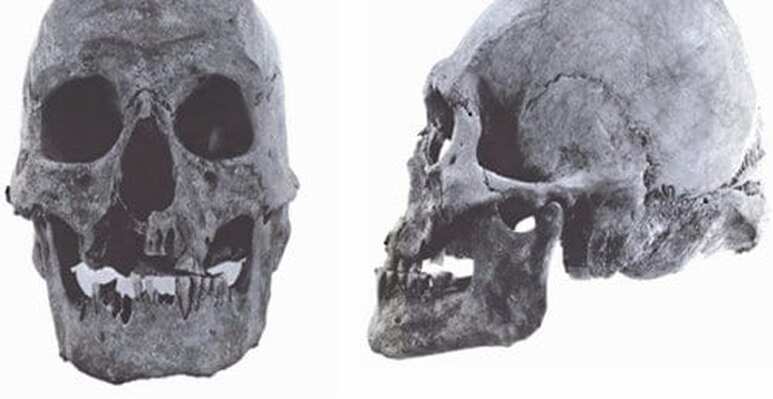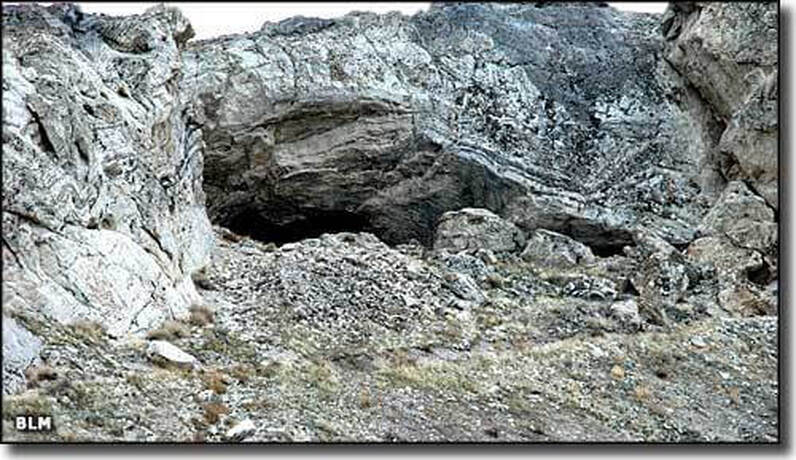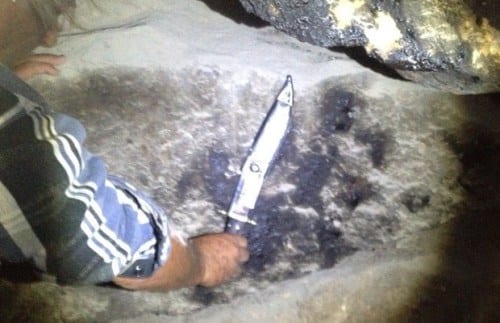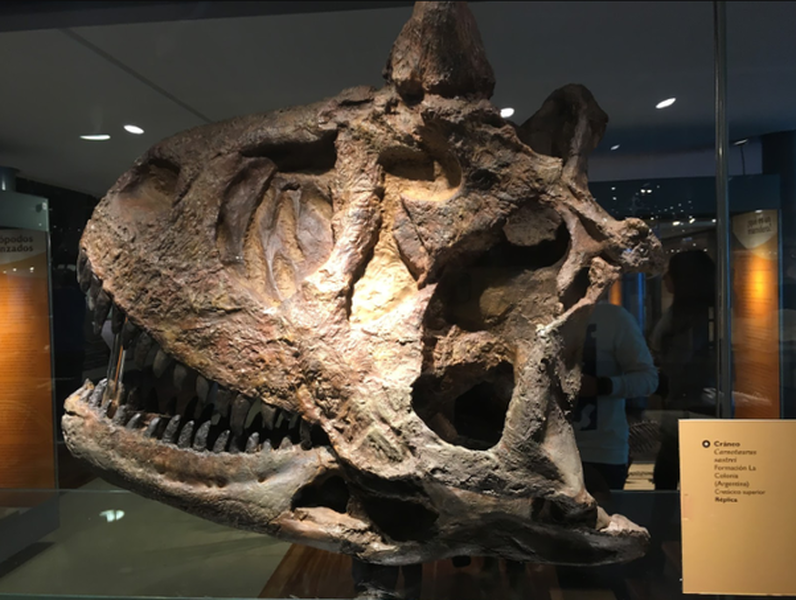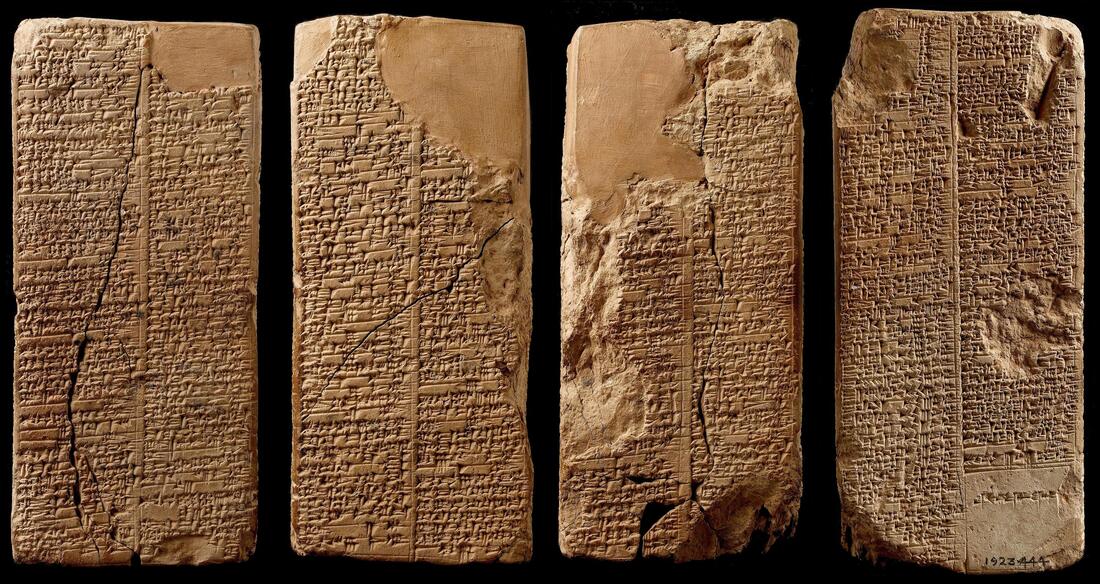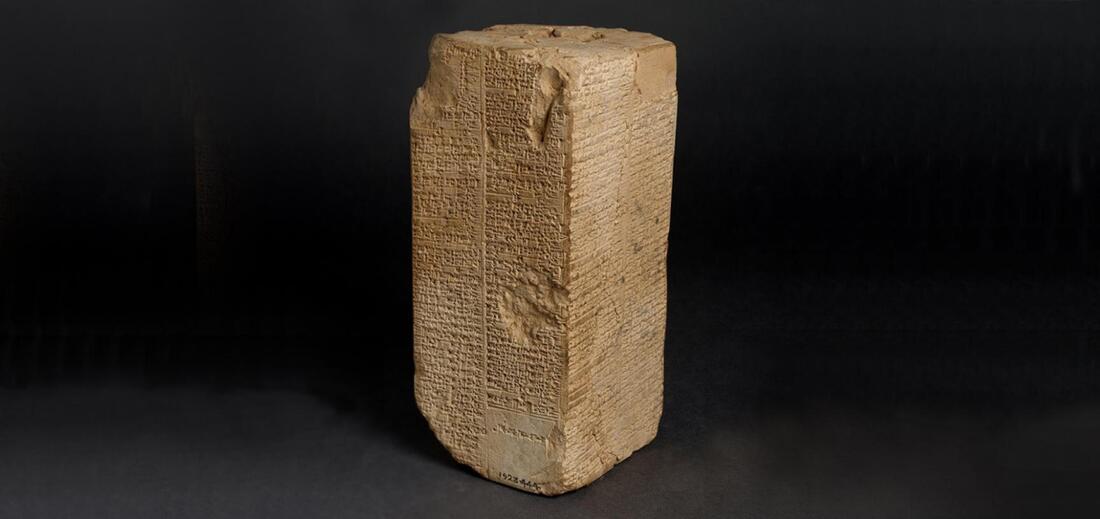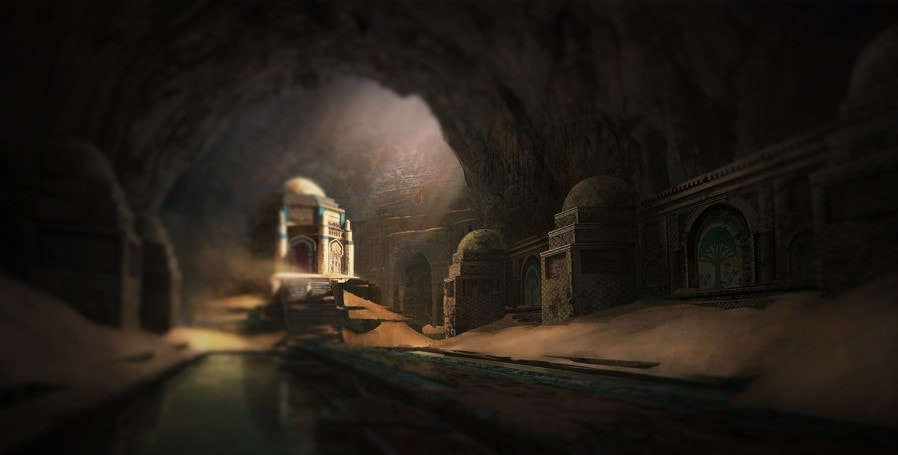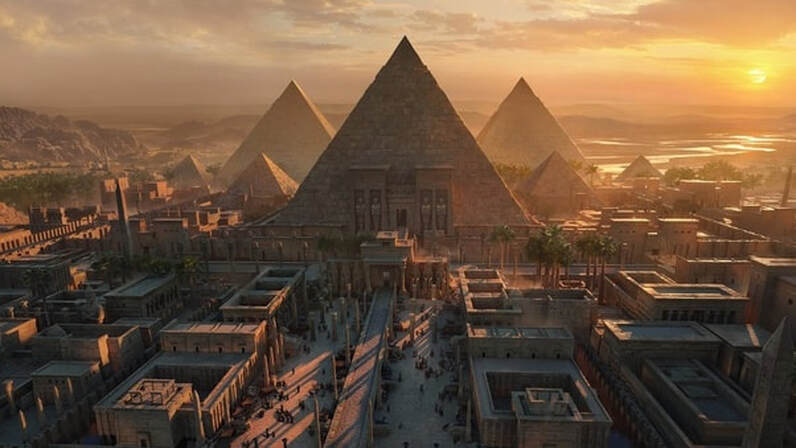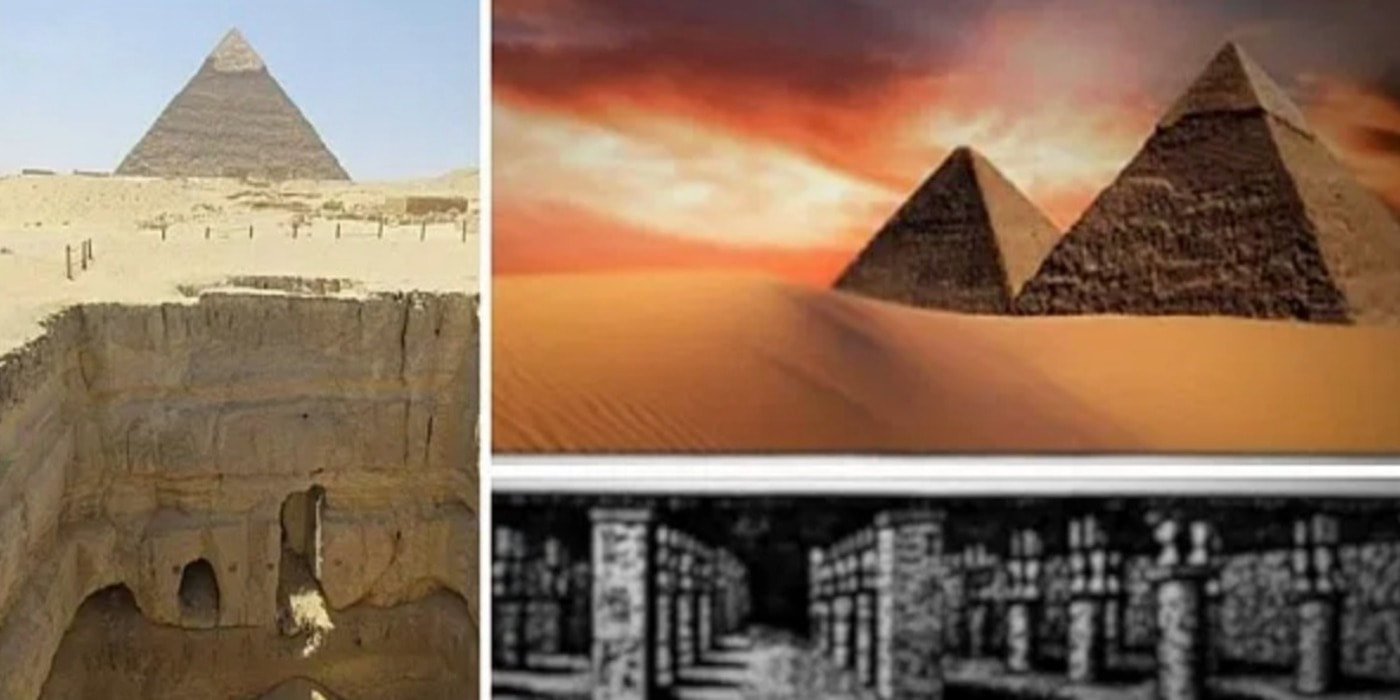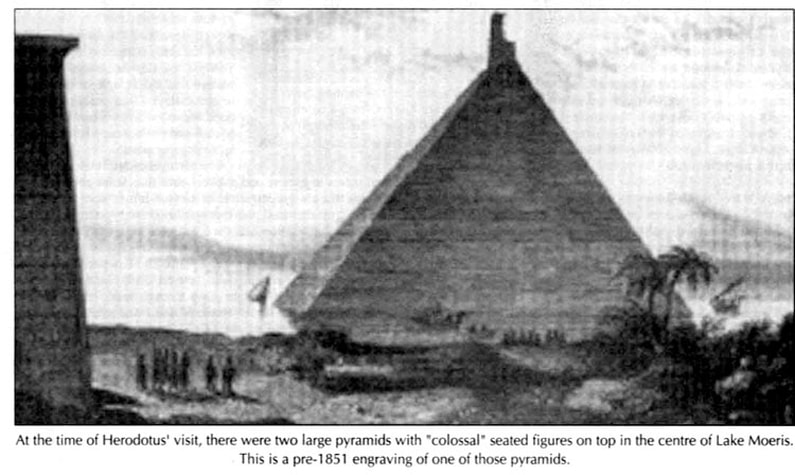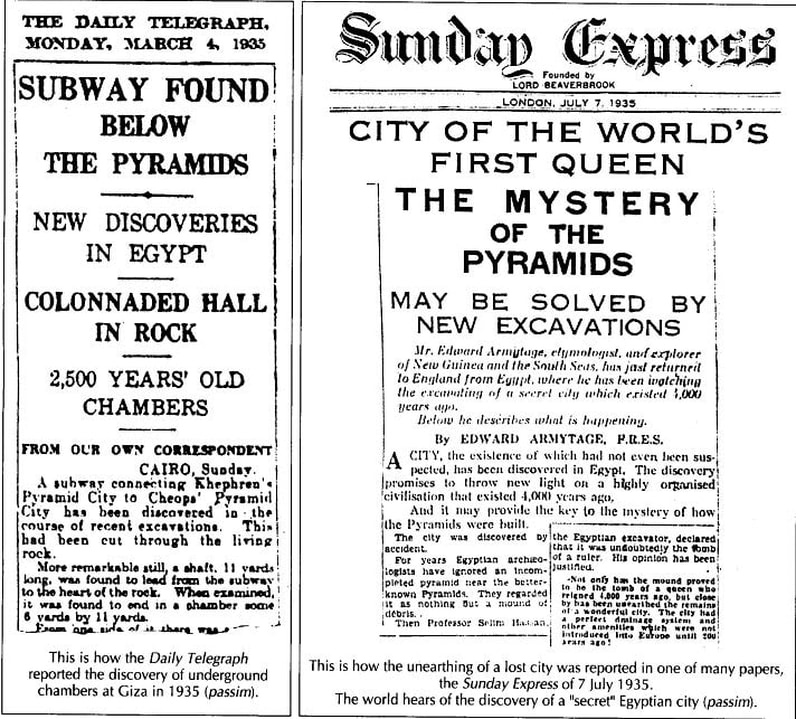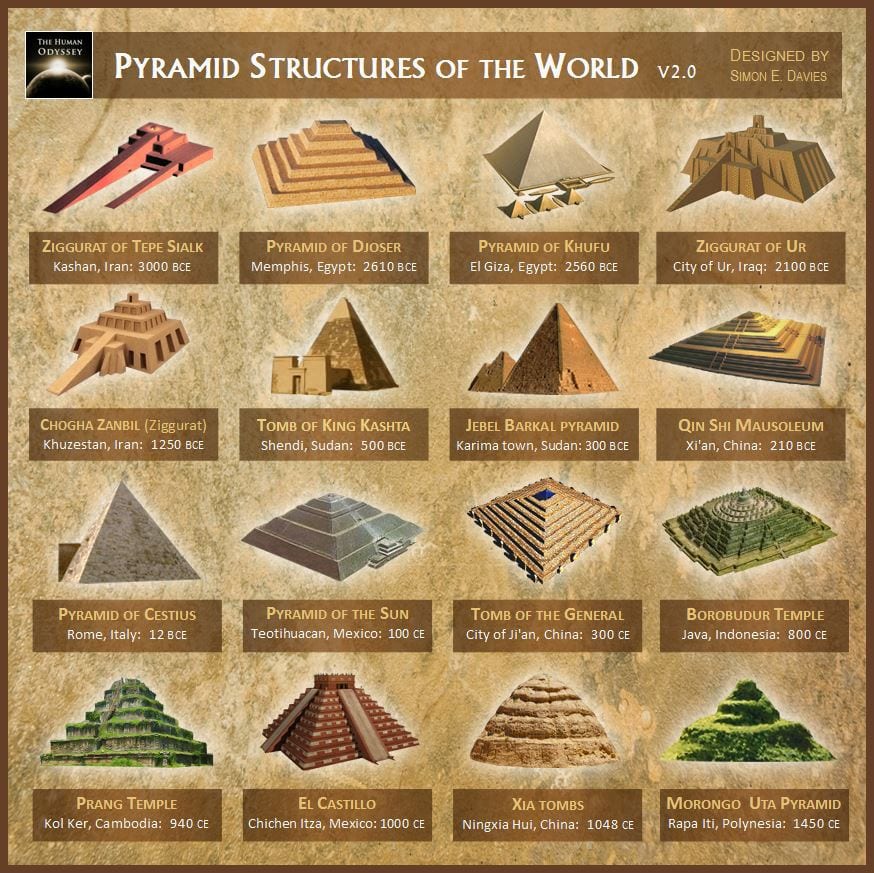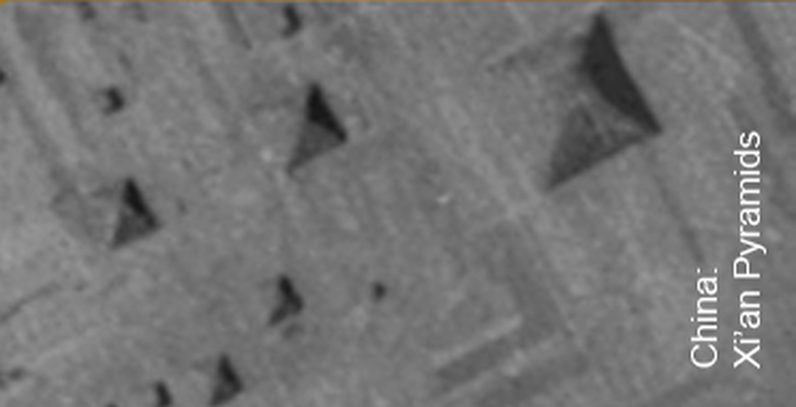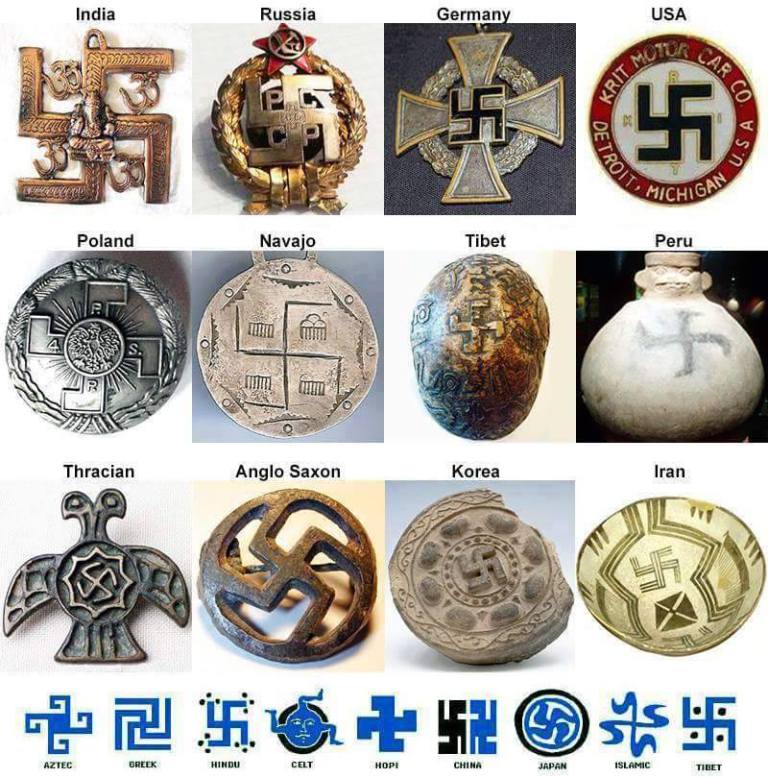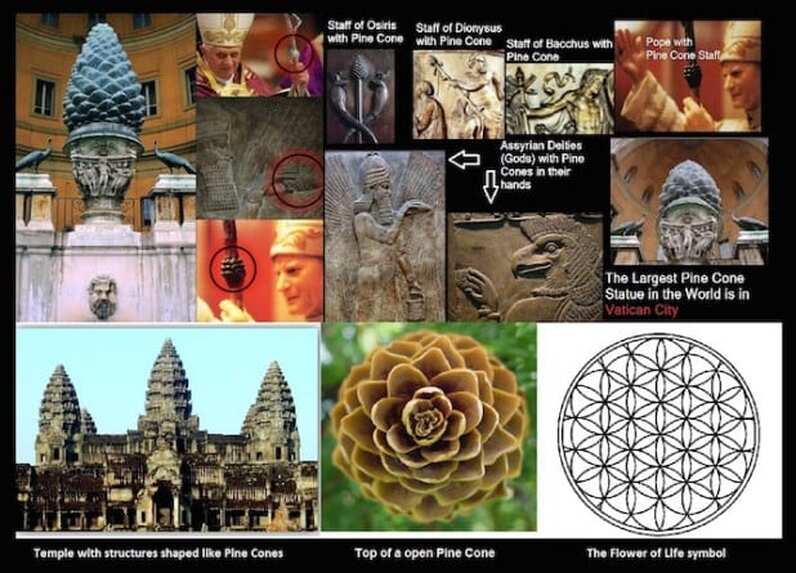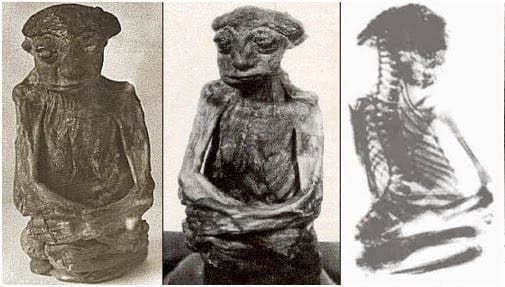|
Archaeologists in Mexico have unearthed a remarkable burial in the ancient ruins of Teotihuacan containing a 1,600-year-old skeleton of an upper-class woman with an elongated skull, stone encrusted teeth and a prosthetic tooth made of a green stone known as serpentine. She was buried with 19 jars of offerings. Agence France-Press reported that the skeleton has been named “The Woman of Tlailotlacan” after the neighbourhood where it was found, just near Mexico’s famous ruins of Teotihuacan, which is located about 30 miles (50 km) northeast of Mexico City. Dating back around 2,500 years, Teotihuacan is one of the largest and most important sacred cities of ancient Mesoamerica, whose name means “the city of the gods” in the Nahuatl language of the Aztecs. It once supported an estimated population of 100,000 – 200,000 people, who raised giant monuments such as the Temple of Quetzalcoatl and the Pyramids of the Sun and the Moon. However, much about Teotihuacan remains unknown, including the origin and language of the people who lived there, as they did not leave behind any written records. The National Anthropology and History Institute (INAH) said the woman, who was between 35 and 40 years old when she died, was a foreigner to the area, as the way in which her skull had been deformed and her teeth encrusted with mineral stones was not usual for that region. The institute said in a statement that her cranium had been elongated by being compressed in a “very extreme” manner, a technique commonly used in the southern part of Mesoamerica, not the central region where she was found. Her teeth contained two round pyrite stones, which were encrusted in her top front teeth. This was a practice that was used among the nobility in Maya regions in southern Mexico and Central America. The Maya are credited with being the masters of cosmetic dentistry as they were known to decorate teeth by embedding them with precious stones or by carving notches and grooves into them. Tiny holes were chipped out of teeth and ornamental stones — including jade — were attached with an adhesive made out of natural resins, such as plant sap, which was mixed with other chemicals and crushed bones. The dentists likely had a sophisticated knowledge of tooth anatomy because they knew how to drill into teeth without hitting the pulp inside. Gold studded teeth, Pre-Columbian Ecuador. Credit: April Holloway Last year, archaeologists discovered liquid mercury in a subterranean tunnel beneath the Temple of the Feathered Serpent in Teotihuacan, which may represent an underworld river that leads the way to a Royal tomb or tombs. The remains of the kings of Teotihuacan, some of the most powerful rulers of the pre-Hispanic world, have never been found. Such a discovery would be monumental as it would unravel many of the mysteries surrounding this ancient civilization.
0 Comments
According to a local media report, the intriguing image was captured by a man named Jeremy as he and his sister were visiting the Whitewater Canyon Wildlife Area in the community of Bernard.
Jeremy, however, swears he saw it moving so it wasn't a shadow, and claims he called out to it as well with no response meaning it probably wasn't a person because we all know anyone in the Midwest would say stop to say hi. Jeremy went on to say, "I was doing a morning walk at White Water Canyon with my sister, who lives up in Dubuque. I pointed out the figure and my sister laughed saying it was a person. We called out to it but got no response."
The photo, which can be seen below, shows what appears to be a bipedal creature of some kind. Alas, like all 'great' potential Sasquatch images and videos, it is incredibly hard to decipher and some observers have argued that the 'creature' is simply a shadow.
"You don't have to believe me. I wouldn't believe me," Jeremy marveled, "but now that I've seen whatever that was first hand. I think I may be a Bigfoot believer now."
Is Bigfoot living in Iowa, or are people just seeing things? The Nebra Sky Disc is a 3,600-year-old bronze disc which, according to UNESCO, features “the oldest concrete depiction of cosmic phenomena worldwide.” The disc is such an extraordinary piece that it was initially believed to be an archaeological forgery. However, detailed scientific analysis revealed that it is indeed authentic and the precious artefact is now included in UNESCO’s ‘Memory of the World’ register, an international initiative launched to safeguard the documentary heritage of humanity, and is being held in the State Museum of Prehistory in Halle. The Nebra Sky Disc was discovered in 1999 by two amateur treasure hunters illegally using a metal detector in Ziegelroda Forest, Saxony-Anhalt, Germany. It had been ritually buried in a prehistoric enclosure atop a hill (the Mittelberg), along with two precious swords, two axes, two spiral arm-rings and one bronze chisel. The enclosure is oriented in such a way that the sun seems to set every solstice behind the Brocken, the highest peak of the Harz Mountains, some 80 km to the north-west. The surrounding area is known to have been settled since the Neolithic, and Ziegelroda Forest is said to contain around 1,000 barrows. The swords found with the disc. Photo source: Wikipedia The scientific studies of the Nebra hoard are probably among the most thorough ever carried out on any archaeological find in Europe. Study began when the objects were first impounded in 2002 and continued until the end of 2007. Nevertheless, dating the artifact has posed many difficulties, and while scientists have been able to determine that it was buried in 1,600 BC, they are unable to determine its date of manufacture, meaning it could be much older than its burial date. The Nebra bronze sky disc measures approximately 30 cm in diameter, weighs 2.2 kg, and is decorated with a blue-green patina and inlaid with gold symbols. These are interpreted generally as a sun or full moon, a lunar crescent, and stars (including a cluster interpreted as the Pleiades). Two golden arcs along the sides were added later (one has since become lost). These were constructed from gold of a different origin, as shown by its chemical impurities. The two arcs span an angle of 82°, correctly indicating the angle between the positions of sunset at summer and winter solstice at the latitude of the Mittelberg (51°N). Mittelberg hill, where the Nebra Sky Disc was found. Photo credit: LDA Sachsen-Anhalt A final addition was another arc at the bottom surrounded with multiple strokes of uncertain meaning, variously interpreted as a Solar Barge (“the sun boat”) with numerous oars, or as the Milky Way. By the time the disc was buried it also had thirty-nine or forty holes punched out around its perimeter, each approximately 3 mm in diameter. According to state archaeologist Harald Meller, it is likely the circular plate represents the Sun not the Moon, given that the arcs relate to solar phenomena. Mittelberg hill, where the Nebra Sky Disc was found. Photo credit: LDA Sachsen-Anhalt According to an initial analysis of trace elements by x-ray fluorescence by E. Pernicka, then at the University of Freiberg, the copper originated at Bischofshofen in Austria, while the gold was thought to be from the Carpathian Mountains. However, a more recent analysis found that the gold used in the first phase was from the river Carnon in Cornwall. The tin content of the bronze was also from Cornwall. The Nebra Sky Disc reconfirms that the astronomical knowledge and abilities of the people of the European Bronze Age included close observation of the yearly course of the Sun, and the angle between its rising and setting points at summer and winter solstice. While much older earthworks and megalithic astronomical complexes such as the Goseck circle or Stonehenge had already been used to mark the solstices, the disc is the oldest known “portable instrument” to allow such measurements. Astronomer Ralph Hansen maintains that the disc was an attempt to co-ordinate the solar and lunar calendars to tell Bronze Age Man when to plant seeds and when to make trades, giving him an almost modern sense of time. “For everyday calendrical purposes, you would use Moon years. But for designing when to plough fields and when to harvest, you use Sun years,” said Hansen. However, not everyone agrees that the Nebra Sky Disc was used for measuring astronomical phenomena. “It’s a difficult question to answer, but I do not think it was used as an instrument used for observing objects in the sky,” said Curt Roslund, an astronomer at Gothenburg. Instead, Roslund argues that few features on the disc tend towards exact representation and that it is more likely to have been of symbolic value – perhaps used in shamanic rituals. UNESCO’s interpretation is that the Sky Disc “combines an extraordinary comprehension of astronomical phenomena with the religious beliefs of its period”, enabling us to gain “unique glimpses into the early knowledge of the heavens.” Addendum: The Disc Has Been Decoded According to researcher Wayne Herschel, author of The Hidden Records, the Nebra Sky Disc does NOT depict our sun and moon. Mr. Herschel was able to decode many ancient star maps and they all point out to a different sun and a different orbiting planet – the home planet of the ancient “gods” that created mankind. According to his website, “There is an interpretation of the Milky Way in relation to the position of the Pleiades which scholars seem to agree upon. Once I knew that, the missing Orion constellation fell into place. It was perfectly presented. There are three dots in the very centre and it fits precisely between the two gold curved edges that adorn the two opposite ends of the disc. “I believe that in all likelihood the crescent on the Nebra disc is not representative of the moon, just as the orb in all likelihood is NOT our Sun. Primarily because the Sun and the stars do not appear concurrently when we look at the sky.” It may seem like the plot of Prometheus, but Wayne Herschel’s book, The Hidden Records, was published in 2006. Did Egyptians cross the Pacific Ocean and wander the American Southwest thousands of years ago? In the early 20th century, claims of such a discovery were made by two Smithsonian-funded archaeologists, who spoke of a thriving civilization tucked within a series of caverns carved into the side of a remote portion of the Grand Canyon. What did the archaeologists find? What evidence did they bring back? Hell, did these men even exist? A parallel North American civilization? A story on the front page of the April 5, 1909 edition of the Arizona Gazette recounted the discovery of a series of bizarre caves and artifacts in the Marble Canyon region of the Grand Canyon. The report claimed two Smithsonian-funded archaeologists, Prof. S. A. Jordan and G.E. Kinkaid, are responsible for the find. As the article noted: “(D)iscoveries which almost conclusively prove that the race which inhabited this mysterious cavern, hewn in solid rock by human hands, was of oriental origin, possibly from Egypt, tracing back to Ramses. “If their theories are borne out by the translation of the tablets engraved with hieroglyphics, the mystery of the prehistoric peoples of North America, their ancient arts, who they were and whence they came, will be solved. “Egypt and the Nile, and Arizona and the Colorado will be linked by a historical chain running back to ages which staggers the wildest fancy of the fictionist.” Later in the article, a cross-legged idol resembling Buddha is described along with a large tomb filled with mummified humans: a veritable mash-up of Egyptian and East Asian cultures. A dangerous region to explore Although this remote area of the Grand Canyon makes for perilous traveling, expeditions by private collectors and academics went forward. The site of Kincaid’s discovery was roughly 42 miles away from El Tovar Crystal Canyon, and the Arizona Gazette article noted that the cavern’s entrance was 1500 feet down a sheer cliff. This is not the easiest terrain to cover, but it’s topography that could be overcome today. Conspiracy theorist John Rhodes claims to know the exact location of the caverns — the site is guarded today by a lone soldier carrying an M-16 and that the caverns are a museum for civilization’s shadowy elites. To make things even more bizarre, David Icke connects Kincaid’s Grand Canyon discovery with reptilian overlords in his 1999 book The Biggest Secret. Smithsonian denials No record exists of Kincaid or Professor Jordan within the Smithsonian’s Department of Anthropology, nor is there a paper trail at the Smithsonian detailing the artifacts gathered on the expedition. When asked directly about Kincaid’s claims, a Smithsonian Institute representative once said: “Well, the first thing I can tell you, before we go any further, is that no Egyptian artifacts of any kind have ever been found in North or South America. Therefore, I can tell you that the Smithsonian Institute has never been involved in any such excavations.” According to conspiracy theorists, the Smithsonian Institute went so far as to destroy artifacts to maintain this historical viewpoint. Espousers of this theory mention man-made mounds with plaster walls strewn across the American Midwest and a series of fire-hewn coffins found in Alabama in 1892 that were turned over the Smithsonian Institute, only to be lost in the years following. A paucity of evidence Kincaid and Jordan returned without artifacts or pictures of the findings, leaving the Arizona Gazette article as the sole evidence of the expedition. No data outside of the article substantiates the existence of Professor Jordan, and Kincaid’s only other known reference comes in a March 12 article in the Arizona Gazette. The March 12 piece notes that Kincaid is in Yuma, Arizona. It mentions simply that he is an avid photographer who carries very high-end photography equipment. This is a particularly questionable tidbit, as no photos of Kincaid’s discovery of the mummified bodies or a Buddha-like statue exist, let alone general photos of this portion of the expedition. It is possible that Kincaid, if he existed, worked under a false name, as the Arizona Gazette articles mentions his hunt for “the mineral”, a euphemism for gold. Theodore Roosevelt made the extraction of gold from the Grand Canyon illegal in 1908 when he deemed the canyon a national forest. All in all, the artifact story was presumably an attempt to drive up sales of a newspaper, or maybe the product of a couple of bored reporters blessed with a bottle of ether and a slow new day. That said, I would watch the hell out of this SyFy movie, particularly if they tied it to the lost Reptilian city under Los Angeles. Was North America once inhabited by a race of cannibalistic giants? According to an old legend supported by several challenging archaeological finds, this unnerving scenario is possible. Many Native American tribes tell stories about the long-forgotten existence of a race of humans that were much taller and stronger than ordinary men. These giants are described as both brave and barbaric and legends often mention their cruelty towards whomever they pleased. The Paiute, a tribe that settled in the Nevada region thousands of years ago, have an outstanding legend about a race of red-haired giants called the Si-Te-Cah. The ancestors of the Paiute described them as savage and inhospitable cannibals. In the Northern Paiute language, ‘Si-Te-Cah’ literally means ‘tule-eaters.’ Legend has it that the giants came from a distant island by crossing the ocean on rafts built using the fibrous tule plant. As odd as it may sound, this legend repeats itself all over the Americas, suggesting it might be an incomplete chronicle of a real event that happened long ago. In Crónicas del Perú, sixteenth century Spanish conquistador Pedro Cieza de León recorded an ancient Peruvian tale about the origin of the South American giants. According to legend, they “came by sea in rafts of reeds after the manner of large boats; some of the men were so tall that from the knee down they were as big as the length of an ordinary fair-sized man.” Could the giants of Peru and the Si-Te-Cah have been survivors of a massive cataclysm who took refuge on the American continent? Legend tells that the Si-Te-Cah waged war on the Paiute and all other neighboring tribes, spreading terror and devastation. Finally, after years of conflict, the tribes united against their common enemy and began to decimate them. The last remaining red-haired giants were chased off and sought shelter inside a cave. With retribution in their minds, the tribes started a fire at the cave entrance, suffocating and burning the Si-Te-Cah alive. Those driven out by the smoke were also killed. The tribes then sealed off the mouth of the cave so that no one might set eyes on those who had once plagued their land. They were all but forgotten until a random event brought them back to light. In 1886, a mining engineer named John T. Reid happened to hear the legend from a group of Paiutes while prospecting near Lovelock, Nevada. The Indians told him that the legend was real and the cave was located nearby. When he saw the cave for himself, Reid knew he was onto something. Many Native American tribes tell stories about the long-forgotten existence of a race of humans that were much taller and stronger than ordinary men. These giants are described as both brave and barbaric and legends often mention their cruelty towards whomever they pleased. The Paiute, a tribe that settled in the Nevada region thousands of years ago, have an outstanding legend about a race of red-haired giants called the Si-Te-Cah. The ancestors of the Paiute described them as savage and inhospitable cannibals. In the Northern Paiute language, ‘Si-Te-Cah’ literally means ‘tule-eaters.’ Legend has it that the giants came from a distant island by crossing the ocean on rafts built using the fibrous tule plant. As odd as it may sound, this legend repeats itself all over the Americas, suggesting it might be an incomplete chronicle of a real event that happened long ago. In Crónicas del Perú, sixteenth century Spanish conquistador Pedro Cieza de León recorded an ancient Peruvian tale about the origin of the South American giants. According to legend, they “came by sea in rafts of reeds after the manner of large boats; some of the men were so tall that from the knee down they were as big as the length of an ordinary fair-sized man.” Could the giants of Peru and the Si-Te-Cah have been survivors of a massive cataclysm who took refuge on the American continent? Legend tells that the Si-Te-Cah waged war on the Paiute and all other neighboring tribes, spreading terror and devastation. Finally, after years of conflict, the tribes united against their common enemy and began to decimate them. The last remaining red-haired giants were chased off and sought shelter inside a cave. With retribution in their minds, the tribes started a fire at the cave entrance, suffocating and burning the Si-Te-Cah alive. Those driven out by the smoke were also killed. Is this the entrance to the resting place of North America’s redheaded giants? The tribes then sealed off the mouth of the cave so that no one might set eyes on those who had once plagued their land. They were all but forgotten until a random event brought them back to light. In 1886, a mining engineer named John T. Reid happened to hear the legend from a group of Paiutes while prospecting near Lovelock, Nevada. The Indians told him that the legend was real and the cave was located nearby. When he saw the cave for himself, Reid knew he was onto something. Reid was unable to begin digging himself but news spread and soon, Lovelock cave was attracting attention. Unfortunately, the attention was profit-driven as guano deposits were discovered inside. A company started by miners David Pugh and James Hart began excavating the precious resource in 1911 and had soon shipped more than 250 tons to a fertilizer company in San Francisco. Any artifacts that might have been discovered were probably neglected or lost. After the surface layer of guano had been mined, strange objects started to surface. This led to an official excavation being performed in 1912 by the University of California, followed by another one in 1924. Reports told about thousands of artifacts being recovered, some of them being truly unusual. Although their claims have not been verified (it comes as no surprise), sources said the mummified remains of several red-haired ancient giants were found buried in the cave. Measuring between 8 to 10 feet in height, these mummies have since been referred to as the Lovelock Giants. Another intriguing find was a pair of 15 inch-long sandals (picture below) that showed signs of having been worn. Allegedly, other unusually large items were recovered but have since been locked away in museum warehouses and private collection. A piece of evidence that remains on-site until this very day is a giant hand print, embedded on a boulder inside Lovelock Cave. Needless to say, this discovery has led many into believing the Paiute legend of the Si-Te-Cah might be more than just folklore. Around the same time as the second Lovelock Cave excavation, another dig revealed a set of equally-disturbing finds. According to a 1931 article published in the Nevada Review-Miner, two giant skeletons had been found buried in a dry lake bed close to Lovelock, Nevada. The over-sized remains measured 8.5, respectively 10 feet in height and were mummified in a manner similar to the one employed by ancient Egyptians. Another common trait between these mummified giant remains and the ones discovered as far south as Lake Titicaca is the presence of red hair. While some scientists believe the reddish color is a result of the interaction with the environment in which they were buried, the mummies verify the legends, which described the Si-Te-Cah and their kin as red-haired giants. Proponents of alternative history believe these violent giants were none other than the biblical Nephilim, the forsworn offspring of the ‘Sons of God’ with the ‘daughters of men.’ If this is true, there’s little chance we might get to see any of the giant mummies. Those interested in keeping history secret will never disclose their location. A recent archaeological discovery that throws a wrench into the conventional theory of evolution has reportedly cost a California professor his job. Mark Armitage, a former scientist at California State University, Northridge (CSUN), was reportedly fired after claiming to have unearthed a dinosaur fossil that still contains soft, flexible tissue, suggesting that it can’t be millions of years old. A 30-year veteran in his field, Armitage has published many studies over the years in peer-reviewed journals. One of his most recent was published last July, pertaining to a discovery he made at the Hell Creek Formation excavation site in Montana. Read also: A Living theropod dinosaur was sighted at Pantanal, a wetland area sparsely populated south of the Amazon. According to The Christian Post, Armitage was evaluating a triceratops horn fossil when he came across preserved soft tissue. A lawsuit recently filed in Armitage’s defense describes his reaction to the discovery as “fascinated,” since flexible matter has never before been discovered on a dinosaur fossil. Naturally, Armitage published his findings — in this case, he published them in the Elsevier journal Acta Histochemica — and proceeded to share his findings with his students. Not long after, Armitage was approached by a CSUN faculty head who reportedly shouted at him, “We are not going to tolerate your religion in this department!” Armitage’s finding, of course, contradicts the evolutionary theory that CSUN has embraced for decades, and there doesn’t appear to be any room for discussion on the matter, since he was also let go from his position. “Terminating an employee because of [his] religious views is completely inappropriate and illegal,” stated Armitage’s lawyer, Brad Dacus, in a public statement. “But doing so in an attempt to silence scientific speech at a public university is even more alarming. This should be a wakeup call and warning to the entire world of academia.” NC paleontologist claims to have explanation for soft tissue, but even this is just a theory Concerning Armitage’s discovery, molecular paleontologist Mary Schweitzer from North Carolina State University (NCSU) claims to have come up with a valid explanation that, though unprovable, is making the media rounds. In a story published by The Huffington Post, Stephanie Pappas explained that iron in dinosaurs’ blood may have a preservative effect on soft tissue. According to the report, Schweitzer and her colleagues had discovered soft tissue in the fossilized leg of a Tyrannosaurus rex, which she says was unusually soft and still transparent for being supposedly 68 million years old. But because its free radical oxidation potential can have an effect similar to formaldehyde, the chemical used in embalming, iron in the creature’s blood may have preserved the soft tissue in ways previously undiscovered. “The problem is, for 300 years, we thought, ‘Well, the organics are all gone, so why should we look for something that’s not going to be there?’ and nobody looks,” was Schweitzer’s explanation as to why soft tissue hasn’t been observed in other fossil excavations. At the same time, Schweitzer’s explanation for the preservation of soft tissue on dinosaur bones is still just a theory, and one that supporters of Armitage say ignores the presence of radioactive carbon-14 in dinosaur fossils. Carbon-14 (C-14) dating of dinosaur bones collected from many different sites across the U.S. have revealed that, at most, these bones are only 39,000 years old. “Dinosaur bones with Carbon-14 dates in the range of 22,000 to 39,000 years before present, combined with the discovery of soft tissue in dinosaur bones, indicate that something is wrong with the conventional wisdom about dinosaurs,” says New Geology. Watch also: Out of the many incredible artifacts that have been recovered from sites in Iraq where flourishing Sumerian cities once stood, few have been more intriguing that the Sumerian King List, an ancient manuscript originally recorded in the Sumerian language, listing kings of Sumer (ancient southern Iraq) from Sumerian and neighboring dynasties, their supposed reign lengths, and the locations of “official” kingship. What makes this artifact so unique is the fact that the list blends apparently mythical pre-dynastic rulers with historical rulers who are known to have existed. The first fragment of this rare and unique text, a 4,000-year-old cuneiform tablet, was found in the early 1900s by German-American scholar Hermann Hilprecht at the site of ancient Nippur and published in 1906. Since Hilprecht’s discovery, at least 18 other exemplars of the king’s list have been found, most of them dating from the second half of the Isin dynasty (c. 2017-1794 BCE.). No two of these documents are identical. However, there is enough common material in all versions of the list to make it clear that they are derived from a single, “ideal” account of Sumerian history. Among all the examples of the Sumerian King List, the Weld-Blundell prism in the Ashmolean Museum cuneiform collection in Oxford represents the most extensive version as well as the most complete copy of the King List. The 8-inch-high prism contains four sides with two columns on each side. It is believed that it originally had a wooden spindle going through its centre so that it could be rotated and read on all four sides. It lists rulers from the antediluvian (“before the flood”) dynasties to the fourteenth ruler of the Isin dynasty (ca. 1763–1753 BC). The list is of immense value because it reflects very old traditions while at the same time providing an important chronological framework relating to the different periods of kingship in Sumeria, and even demonstrates remarkable parallels to accounts in Genesis. The ancient civilization of Sumer Sumer (sometimes called Sumeria), is the site of the earliest known civilization, located in the southernmost part of Mesopotamia between the Tigris and the Euphrates rivers, in the area that later became Babylonia and is now southern Iraq from around Baghdad to the Persian Gulf. By the 3rd millennium BC, Sumer was the site of at least twelve separate city states: Kish, Erech, Ur,Sippar, Akshak, Larak, Nippur, Adab, Umma, Lagash, Bad-tibira, and Larsa. Each of these states comprised a walled city and its surrounding villages and land, and each worshiped its own deity, whose temple was the central structure of the city. Political power originally belonged to the citizens, but, as rivalry between the various city-states increased, each adopted the institution of kingship. The Sumerian King List, records that eight kings reigned before a great flood. After the Flood, various city-states and their dynasties of kings temporarily gained power over the others. Sumer’s mythical past The Sumerian King List begins with the very origin of kingship, which is seen as a divine institution: “the kingship had descended from heaven”. The rulers in the earliest dynasties are represented as reigning fantastically long periods: “After the kingship descended from [the] heaven[s], the kingship was in Eridug. In Eridug, Alulim became king; he ruled for 28800 years. Alaljar ruled for 36000 years. 2 kings; they ruled for 64800 years.” Some of the rulers mentioned in the early list, such as Etana, Lugal-banda and Gilgamesh, are mythical or legendary figures whose heroic feats are subjects of a series of Sumerian and Babylonian narrative compositions. The early list names eight kings with a total of 241,200 years from the time when kingship “descended from [the] heaven[s]” to the time when “the Flood” swept over the land and once more “the kingship was lowered from heaven” after the Flood. Interpretation of long reigns The amazingly long tenure of the early kings has provoked many attempts at interpretation. At one extreme is the complete dismissal of the astronomically large figures as “completely artificial” and the view that they are unworthy of serious consideration. At the other extreme, is the belief that the numbers have a basis in reality and that the early kings were indeed gods who were capable of living much longer than humans. In between the two extremes is the hypothesis that the figures represent relative power, triumph or importance. For example, in ancient Egypt, the phrase “he died aged 110” referred to someone who lived life to the full and who offered an important contribution to society. In the same way, the extremely long periods of reign of the early kings may represent how incredibly important they were perceived as being in the eyes of the people. This doesn’t explain, however, why the periods of tenure later switched to realistic time periods. Related to this perspective is the belief that although the early kings are historically unattested, this does not preclude their possible correspondence with historical rulers who were later mythicised. Finally, some scholars have sought to explain the figures through a mathematical investigation and interpretation (e.g. Harrison, 1993). Relation to Genesis Some scholars (e.g. Wood, 2003) have drawn attention to the fact that there are remarkable similarities between the Sumerian King List and accounts in Genesis. For example, the Genesis tells the story of ‘the great flood’ and Noah’s efforts to save all the species of animals on Earth from destruction. Likewise, in the Sumerian King List, there is discussion of a great deluge: “the flood swept over the earth.” The Sumerian King List provides a list of eight kings (some versions have 10) who reigned for long periods of time before the flood, ranging from 18,600 to 43,200 years. This is similar to Genesis 5, where the generations from Creation to the Flood are recorded. Interestingly, between Adam and Noah there are eight generations, just as there are eight kings between the beginning of kingship and the flood in the Sumerian King List. After the flood, the King List records kings who ruled for much shorter periods of time. Thus, the Sumerian King List not only documents a great flood early in man’s history, but it also reflects the same pattern of decreasing longevity as found in the Bible -- men had extremely long life spans before the flood and much shorter life spans following the flood (Wood, 2003). The Sumerian King List truly is a perplexing mystery. Why would the Sumerians combine mythical rulers with actual historical rulers in one document? Why are there so many similarities with Genesis? Why were ancient kings described as ruling for thousands of years? These are just some of the questions that still remain unanswered after more than a century of research. Addendum In my opinion, it makes no sense for a species to tangle their true history with mythical stories and, giving the fact that the Sumerians were extremely knowledgeable in so many different fields, it is obvious that they knew exactly what they were talking about (meaning that these events actually took place). One of the harder things to digest for some people, is the extremely long lifespan of these heavenly kings (i.e. the Anunnaki). In my opinion, these cargo-cult gods had discovered “the fountain of youth,” meaning that they could not die from natural causes. Humans only start aging sometime in their late 20s, when their cells start diving slower (eventually, cells will stop dividing completely). But an ancient and technologically advanced species such as the Anunnaki would have no problems genetically engineering their bodies so that they could live forever. For further references, please check out the immortal HeLa cells. As expected, science can go very far from there and, in my opinion, we are only centuries away from discovering immortality ourselves. A couple of interesting features of the human bodies are the following: a fetus can grow back limbs while still in the womb and our skeletons continue to develop until the age of 79 (hips widen and skulls increases in volume). So, why do we start aging in our late 20s and why can’t we grow back limbs after we are born? Has our DNA been tempered with? Have we been genetically-programmed to live short lives? There is an incredible ‘Lost’ underground city located beneath the Pyramids of Giza, and despite the fact that only a few know about it today, it was extremely well documented in the past. The mysterious Giza Plateau is even more mind-boggling once you realize the ancient city of Memphis (modern-day Giza) is filled with subterranean passageways, shafts, a cavern system and chambers which hold in their walls, thousands of years worth of history together with countless artifacts. However, Egyptian authorities are not willing to reveal what is found beneath Giza to the general public, like many other discoveries made throughout the years in Egypt. There is a lost history completely ignored by mainstream scholars when it comes to the Ancient Egyptian Civilization and the enigmatic Pyramids which according to many predate the Egyptian Civilization itself. In order to comprehend to the full extent the partial pieces of history we have been taught in school, we must understand that countless discoveries on our planet have been completely ignored by mainstream scholars. One of those discoveries took place in Egypt, where a massive subterranean tunnel system with chambers and rooms was discovered below the surface of the Pyramid Plateau. A genuine history of what happened beneath the sands thousands of years ago is not present in mainstream teachings of our civilizations past, and reflection of that are the countless discoveries made in the last decades which clearly indicate, history as we know it is only partial. In order to understand the enigmatic underground ‘city’ located beneath the Giza Plateau, we venture out the Fayum Oasis district located a few miles outside the Memphis Nome. It is noteworthy to mention that in the past, Lake Moeris bordered the Fayum Oasis and just at its shores was the enigmatic Labyrinth described by Herodotus as “an endless wonder to me.” It is said that the mysterious ‘Labyrinth’ of impressive size, contained up to 1500 rooms and an equal amount of subterranean chambers which the Greek philosopher was not permitted to inspect. According to the keepers of the Labyrinth, “the passages were baffling and intricate”, created in order to keep the countless ancient texts and scrolls safe in the many underground chambers. In fact, this ancient complex impressed Herodotus in such a way that he felt compelled to speak about the mysterious structure: There I saw twelve palaces regularly disposed, which had communication with each other, interspersed with terraces and arranged around twelve halls. It is hard to believe they are the work of man, The walls are covered with carved figures, and each court is exquisitely built of white marble and surrounded by a colonnade. Near the corner where the labyrinth ends, there is a pyramid, two hundred and forty feet in height, with great carved figures of animals on it and an underground passage by which it can be entered. I was told very credibly that underground chambers and passages connected this pyramid with the pyramids at Memphis. In fact, ancient Memphis (Giza) has a humongous underground system that combines a set of intricate man-made passageways and subterranean rivers and tunnels. While these were described thousands of years ago, the gigantic underground cavities were mapped since 1978 using ground penetrating radar thanks to explorations led by Dr. Jim Hurtak, who is said to have entered massive chambers that are larger than the largest cathedrals ever erected by modern man. However, in addition to the above, he also spoke of the gigantic underground metropolis located beneath the Giza Plateau said to be at least 15,000 years old. Interestingly, there are numerous ancient authors who supported Herodotus’ record of underground passages connecting major pyramids. It is important to mention that Iamblichus, also known as Iamblichus Chalcidensis, or Iamblichus of Apamea, a Syrian Neoplatonist philosopher recorded information about an entrance through the body of the Sphinx leading inside the Great Pyramid of Giza: This entrance obstructed in our day by sands and rubbish, may still be traced between the forelegs of the crouched colossus. It was formerly closed by a bronze gate whose secret spring could be operated only by the Magi. It was guarded by public respect, and a sort of religious fear maintained its inviolability better than armed protection would have done. In the belly of the Sphinx were cut out galleries leading to the subterranean part of the Great Pyramid. These galleries were so artfully crisscrossed along their course to the Pyramid that, in setting forth into the passage without a guide throughout this network, one increasingly and inevitably returned to the starting point. Crantor (300BC) claimed that a set of underground pillars in Egypt contain written stone records of pre-history, Crantor too supported Herodotus’ writings. However, even more interesting is the fact that written on ancient Sumerian cylinder seals are the records of the Anunnaki and their secret abode, which was described as: “an underground place… entered through a tunnel, its entrance hidden by sand and by what they call Huwana… his teeth as the teeth of a dragon, his face the face of a lion”. This extremely ancient texts, fragmented into several pieces also records that “He [Huwana] is unable to move forward, nor is he able to move back” but they crept up on him from behind, and the way to “the secret abode of the Anunnaki” was no longer blocked. (source) The Ancient Sumerian texts surprisingly provided a relatively good description of the lion-headed Sphinx at Giza, a monument that surely predates the Ancient Egyptian civilizations and was set in place to guard the Pyramids and countless chambers and tunnels located beneath Giza. However, we find more evidence of vast underground chambers in the writings of first-century Roman historian Pliny, who documented that located beneath the mighty Sphinx there is a concealed “tomb of a ruler named Harmakhis that contains great treasure.” Surprisingly, the Great Sphinx was once called “The Great Sphinx Harmakhis who mounted guard since the time of the Followers of Horus.” The 10th Sumerian Tablet: The Anunnaki Built The Pyramids Further proof supporting the existence of the subterranean vaults is documented by fourth-century Roman historian Ammianus Marcellinus who documented the existence of passageways that lead to the interior of the Great Pyramid at Giza: „Inscriptions which the ancients asserted were engraved on the walls of certain underground galleries and passages were constructed deep in the dark interior to preserve ancient wisdom from being lost in the flood.“ More evidence is found in a manuscript documented by Arab writer Altelemsani and preserved in the British Museum. Altelemsani documented the existence of an extensive square underground chamber located below ground, between the Great Pyramid and the River Nile. Altelemsani wrote there was something enormous blocking the entrance from the River Nile. Altelemsani wrote: “…In the days of Ahmed Ben Touloun, a party entered the Great Pyramid through the tunnel and found in a side-chamber a goblet of a glass of rare color and texture. As they were leaving, they missed one of the party and, upon returning to seek him, he came out to them naked and laughing said, “Do not follow or seek for me”, and then rushed back into the pyramid. His friends perceived that he was enchanted. Upon learning about strange happenings under the Pyramid, Ahmed Ben Touloun expressed a desire to see the goblet of glass. During the examination, it was filled with water and weighed, then emptied and re-weighed. The historian wrote that it was “found to be of the same weight when empty as when full of water.” (source) Interestingly during the 10th century, a writer by the name of Masoudi claimed that advanced mechanical statues were guardians of the subterranean galleries located under the Great Pyramid of Giza. His description, one thousand years ago can be compared in significance to computerized robots seen today. According to Masoudi, these robots were programmed to destroy all “except those who by their conduct were worthy of admission”. He wrote: “…written accounts of Wisdom and acquirements in the different arts and sciences were hidden deep, that they might remain as records for the benefit of those who could afterward comprehend them…”. Masoudi confessed: “…I have seen things that one does not describe for fear of making people doubt one’s intelligence… but still I have seen them…”. According to Herodotus, ancient Egyptian priests spoke of a long-held tradition of the creation of underground chambers by the original builders of ancient Memphis. Interestingly, these stories were confirmed when large cavities were discovered during a survey conducted at Giza in 1993. Reports supporting the existence of vast chambers was documented by a newspaper report called “Mystery Tunnel in Sphinx“: “Workers repairing the ailing Sphinx have discovered an ancient passage leading deep into the body of the mysterious monument. The Giza Antiquities chief, Mr. Zahi Hawass, said there was no dispute the tunnel was very old. However, what is puzzling is: who built the passage? Why? Moreover, where does it lead…? Mr. Hawass said he had no plans to remove the stones blocking the entrance. The secret tunnel burrows into the northern side of the Sphinx, about halfway between the Sphinx’s outstretched paws and its tail.” (source) In 1935, incredible stories emerged after a decade-long clearing project took place. An article published the same year by Hamilton M. Wright described the existence of the areas under Giza. This information, like many other discoveries, are still denied by Egyptian authorities despite extensive evidence proving their existence. The article read: “…We have discovered a subway used by the ancient Egyptians of 5000 years ago. It passes beneath the causeway leading between the second Pyramid and the Sphinx. It provides a means of passing under the causeway from the Cheops Pyramid to the Pyramid of Chephren [Khephren]. From this subway, we have unearthed a series of shafts leading down more than 125 feet, with roomy courts and side chambers…”. (source) The existence of the extensive underground chambers az Giza is extremely well documented, even though a few people around the world know of its existence. Media reports in the 1930’s described subterranean chambers and passageways located between the Temple of the ‘Solar-men’ located on the plateau and the temple of the Sphinx in the Giza Valley. Located in the middle between the Great Sphinx and the Great Pyramid, four enormous vertical shafts, each approximately eight feet square, leading into inner chambers through solid limestone were also discovered. “…It is called “Campbell’s Tomb” on the Masonic and Rosicrucian plans, and “that shaft complex,” said Dr. Selim Hassan, “ended in a spacious room, in the center of which was another shaft that descended to a roomy court flanked with seven side chambers…”. According to reports, inside of the secret rooms were huge, sealed sarcophagi of basalt and granite, 18 feet high. In 1935, when Dr. Selim Hassan was exploring the area he wrote: “…We are hoping to find some monuments of importance after clearing out this water. The total depth of these series of shafts is more than 40 meters or more than 125 feet… In the course of clearing the southern part of the subway, there was found a very fine head of a statue which is very expressive in every detail of the face…“. (source) Chapel Of Offerings, Enoch, And Pre-Historic AccountsIn addition to the above, Dr. Selim Hassan also reported the discovery of three inner and outer courts and a room they called the ‘Chapel of offerings,’ cut into a massive rock outcrop found between Campbell’s Tomb and the Great Pyramid. Reports indicate that at the center of the chapel are three ornate vertical pillars positioned in a triangular-shaped layout. The pillars are extremely important points in the report since their existence is believed to have been recorded in the Bible. It is believed that Ezra, the initiated Torah writer had knowledge of the existence of the passages and large chambers beneath Giza even before he wrote the Torah. Interestingly, reports of ‘sophisticated moving machines’ discovered at Giza, together with a previously unknown subterranean city are found in an article written by the Sunday Express of 7 July 1935. However, despite extensive ancient texts documenting the existence of vast tunnels, chambers and passageways underneath Giza, Egyptian Authorities have long denied the existence of these, together with a number of other incredible discoveries in Egypt. According to reports, the now ‘inaccessible’ underground city can be accessed from inside the Sphinx (but other parts as well), with stairs cut into solid rock, leading down to the cavern system below the bedrock of the river Nile. The huge, complex, underground system below the Giza Plateau extends east, leading towards Cairo. In an article written in 1972 the following statement was made: “No one should pay any attention to the preposterous claims in regard to the interior of the Great Pyramid or the presumed passageways and unexcavated temples and halls beneath the sand in the Pyramid district made by those who are as associated with the so-called, secret cults or mystery societies of Egypt and the Orient. These things exist only in the minds of those who seek to attract the seekers for mystery, and the more we deny the existence of these things, the more the public is led to suspect that we are deliberately trying to hide that which constitutes one of the great secrets of Egypt. It is better for us to ignore all of these claims than merely deny them. All of our excavations in the territory of the Pyramid have failed to reveal any underground passageways or halls, temples, grottos , or anything of the kind except the one temple adjoining the Sphinx.” (source) Historical texts document the extensive amount of excavations made during the 20th century, incredible mindboggling discoveries that are kept away from society. As we have mentioned in previous articles, there is a specific and strict pattern implemented in today’s society where only certain information is released to the world, while most parts are kept locked away from prying eyes, almost as if there is a hidden level of censorship in operation, specifically designed to protect parts of the history belonging to mankind, a species with amnesia. One of the questions most of us have asked about ancient history is why did so any ancient civilizations build Pyramids all over the world? If these ancient civilizations weren’t interconnected in one way or another… why did they follow a nearly identical architectural pattern? Did they have the same instructor? There are countless enigmatic questions that still remain a mystery for mainstream scholars when it comes to ancient civilizations and their development. Here we have a few of the most incredible similarities among prehistoric civilizations that prove they shared a universal scientific knowledge, something that mainstream scholars are certain is impossible. 1. Why did the ancients build Pyramids, all over the word? We start off with the building of the Pyramids. These majestic ancient monuments can be found in all corners of the world, from stepped pyramids, circular and classic pyramid, nearly all ancient cultures around the world built incredible Pyramids that challenge our modern-day understanding of some of the most incredible ancient civilizations on Earth. The Ancient Egyptians, Ancient Chinese, Pre-Inca, Inca, Aztecs, Maya and countless other ancient cultures erected Pyramids that still exist today. No one has been able to understand what the real purpose of the pyramids was… Where they meant to be used as tombs? As Storage rooms? As monuments to honor the Gods? Or is it possible that, as many believe today, Pyramids were built to harness the natural energy of the planet and the universe? The Mystery regarding pyramids deepens when you realize that some of them, like the pyramids located in the Giza Plateau are astronomically aligned. The truth is that, even though we have tried really hard in understanding the fundamental principles of the pyramids that ancient cultures built, we still have no idea how they were able to erect this majestic buildings and what their true purpose was. Pyramids and their celestial connection The Xi’an pyramids of China: The fact that Cultures and ancient civilizations around the world built incredible monuments is something fascinating, and the fact that nearly all of them share incredible architectural similarities is mind boggling, but we cannot forget their celestial connection that most of them share as well. If we look at the Pyramids at the Giza Plateau, at the Pyramids of Teotihuacan and even the Chinese Pyramids, we will find out that all of them seem to be aligned to particular constellations. In this case we are talking about the Constellation of Orion, which apparently was of extreme importance not only to the Ancient Egyptians, but to the Ancient Aztecs and their predecessors, the Ancient Chinese and other ancient civilizations around the world. How was ancient mankind capable of positioning monuments which such precision in order to mimic the cosmos is something no one has been able to fully understand, and it remains as one of the greatest enigmas ever. Ancient Metal Clamps… Evidence of lost ancient technology? Are the ancient metal clamps real evidence of a lost advanced technology waiting to be re-discovered? Traces of this alleged los technology can be found on megaliths temples and numerous other prehistoric monuments around the world. What was the true purpose of these ancient metal clamps? And the more important questions no one has been able to answer is: How did this ancient technology spread to other parts of the globe? Evidence of the ancient metal clamps can be found in constructions in Ancient Egypt, Ancient Greece, Pre-Inca, Inca and other parts of the world. Is it possible that these ancient builders ad the same teacher? Did they follow the same patter just as they did when they started building Pyramids? The mysterious T-Grooves have been discovered n Tiahuanaco, Ollantaytambo, Koricancha and the site of Yuroc Rumi, Vilcabamba. These clamps were also used on the Parthenon, on buildings in Mesopotamia, Egypt and Cambodia. While scientists are still unsure about the exact purpose of the mysterious T-Grooves, some have suggested that they might have been used for some sort of ceremonial purpose while other point that the ancient metallic clamps might have been used to keep huge boulders together, in the right position. The Swastika symbol, present in nearly every culture of the past The Swastika, also referred to as the gammadion, is one of the oldest and most widespread symbols on planet Earth. And if you thought it is a symbol that represents evil and death, you are very very wrong. To make it short and clear, the Swastika symbol stands for peace and prosperity and is a very positive symbol. It is considered a universal symbol and was used by numerous cultures and ancient civilizations throughout history. As we know it today, Swastika is actually a Sanskrit word which means “that which is good” or “all is well” but some translate it to “lucky or auspicious object”, whatever the translation it is a very positive symbol. In Hinduism it is a very sacred symbol deeply connected with luck and prosperity, and yes, there is a lot to be learned about this ancient symbol which has been misinterpreted since 1900’s. Archaeologists have debated about the exact origin and date of the Swastika symbols. Recent research has shown that the earliest known object with swastika-motifs is a bird from the tusk of a mammoth from the Paleolithic settlement of Mezine, Ukraine which dates back between 10,000 and 12,000 BCE. The vinca culture is among the earliest cultures that utilized the swastika symbol. In Asia, many business organizations use the Swastika symbol officially; for example the Ahmedabad Stock Exchange and the Nepal Chamber of Commerce use it. Why the symbol of the Swastika spread across the entire planet is still a mystery that archaeologists and historians have failed to understand. 4. The Pine Cone Symbol: Found in nearly every culture around the Globe From Ancient Rome to Ancient Mesopotamia, the Pine Cone symbols is without a doubt one of the most mysterious symbols found in ancient art and architecture. According to many researchers, the Pine Cone symbol points towards the highest degree of spiritual illumination possible, something that was recognized by nearly every single ancient cultures around the globe, embedded into their monuments and art including the Indonesians, Babylonians, Egyptians, Greeks, and Romans. Strangely, the Pine Cone appeared to have had the same meaning for all of the ancient cultures, symbolizing the secret vestigial organ: the Pineal Gland, also referred to as the “Third Eye.” Why this ancient symbol spread across numerous ancient civilization is a mystery that just like the Pyramids and Metal Clamps, researchers have failed to understand. In June 1934, two gold prospectors, who had been digging and blasting for gold within the San Pedro Mountains in Wyoming, came across a small cavern buried deep within the thick rock. When the dust began to settle, the prospectors made a startling discovery – the well-preserved, but long-forgotten, remains of a tiny human. The origins of this little human were a mystery. Local Native American tribes were known to tell stories of legendary “tiny people,” “little spirits”, or the Nimeriga. In some of these stories, the small people had magical powers, or healing powers. In other stories, they were a vicious tribe who attacked the Native Americans with poisoned arrows. The discovery of the mummified remains drew much attention to the area, eliciting many questions, and creating controversy. There were many who doubted the veracity of the prospectors’ story, believing the remains to be fabricated, and the story a hoax. Scientists flocked to the area, all with a deep desire to determine the truth behind the tiny person, nicknamed “Pedro.” With a sitting height of six and ½ inches, and an estimated standing height of fourteen inches, it was clear that these were no ordinary remains. The scientists conducted extensive testing on Pedro. First, they reviewed the outward physical evidence. Pedro was found in a sitting position, cross-legged, on a small ledge within what appeared to be a man-made cave. With bulging eyes and a flattened cranium, Pedro was extremely well preserved – so much so that even his fingernails were visible. A gelatinous substance covered Pedro’s head, and it became clear that liquids had been used to preserve the body. His nose was flattened, he had a full set of teeth, and his skin was brown and wrinkled, creating the appearance of an old man. Photos and x-ray of the San Pedro Mummy. Image source: Wikipedia; In the years following the discovery of Pedro, scientists conducted more invasive testing, utilizing x-rays to try to unlock the mystery. Several anthropologists initially concluded that the remains were those of an infant, likely born prematurely, or who died shortly after birth. This, however, is an area of disagreement, as a second body of scientists believe the remains to be those of an adult, possibly 16-65 years in age. It has been said that x-rays revealed sharp teeth, and the presence of food in the stomach that appeared to be raw meat. The x-rays also suggested that Pedro had suffered a violent death, showing broken bones, a damaged spine, and damage to the skull. The discovery of the mummified remains led to significant speculation that the remains were a hoax. The presence of the gelatinous substance on Pedro’s head led some to believe that the remains were actually those of a deceased infant, recovered from a medical facility, or that the prospectors had created the remains using a crude form of taxidermy. However, others maintained the remains were evidence of a Leprechaun-like race, like those mentioned in the legends of the local indigenous people, or evidence of an extra-terrestrial being. It was difficult for many to fathom that a human of such tiny stature could possibly be an adult. While modern testing could provide many more answers about the origins of Pedro, such testing is not possible because the location of the remains has been unknown for several years. It is said that the remains were put on display during sideshows in the 1940s, and were then purchased by a man named Ivan Goodman. Upon Goodman’s death in 1950, the remains passed to a man named Leonard Waller (sometimes reported as Walder). The remains have not been seen since. With the remains nowhere to be found, the mysteries of Pedro linger to this day. Most scientists agree that Pedro’s remains were those of an adult male human. However, modern testing could have answered so many additional questions like where he came from, whether he suffered any diseases or congenital conditions, what the gelatinous substance was, and how his remains come to be sealed within a thick layer of rock. The answers to these questions, and many others, are likely to remain unanswered unless the remains can be located and further tested. Until then, scientists and enthusiasts can only speculate about who or what he was. |
Helena MatiasEditor Archives
July 2024
Please take a look below at the amazing work of Author and researcher Stephen Quayle
Categories
All
|
